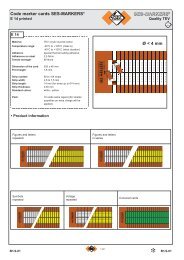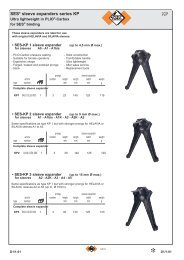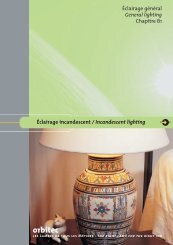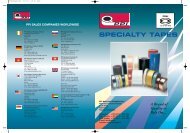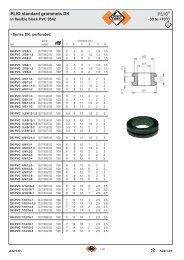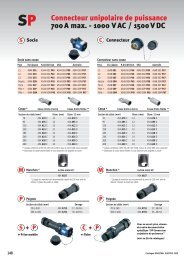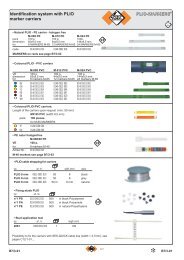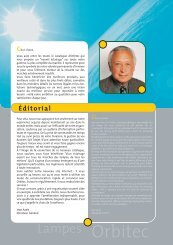Kapton Data Sheet - Professional Plastics
Kapton Data Sheet - Professional Plastics
Kapton Data Sheet - Professional Plastics
You also want an ePaper? Increase the reach of your titles
YUMPU automatically turns print PDFs into web optimized ePapers that Google loves.
Safety and Handling<br />
Safety and Handling<br />
Safe handling of Type HN and VN <strong>Kapton</strong> ®<br />
polyimide films at high temperatures requires<br />
adequate ventilation. Meeting the requirements<br />
of OSHA (29 CFR 1910.1000) will provide<br />
adequate ventilation. If small quantities of<br />
<strong>Kapton</strong> ® are involved, as is often the case,<br />
normal air circulation will be all that is needed<br />
in case of overheating. Whether or not existing<br />
ventilation is adequate will depend on the<br />
combined factors of film quantity, temperature,<br />
and exposure time. For additional information<br />
on the Teflon ® FEP coating used on Type FN<br />
<strong>Kapton</strong> ® , refer to the booklet “Guide to the Safe<br />
Handling of Fluoropolymer Resins” (H-48633).<br />
Soldering and<br />
Hot Wire Stripping<br />
Major uses for all types of <strong>Kapton</strong> ® include<br />
electrical insulation for wire and cable and<br />
other electronic equipment. In virtually all of<br />
these applications, soldering is a routine<br />
fabricating procedure, as is the use of a heated<br />
element, to remove insulation. Soldering<br />
operations rarely produce off-gases to be of<br />
toxicological significance.<br />
Welding and Flame Cutting<br />
Direct application of welding arcs and torches<br />
can quickly destroy most plastics, including all<br />
types of <strong>Kapton</strong> ® film. For practical reasons,<br />
therefore, it is best to remove all such parts<br />
from equipment to be welded. Where removal<br />
is not possible, such as in welding or cutting<br />
coated parts, mechanical ventilation should be<br />
provided. Because <strong>Kapton</strong> ® can be used at very<br />
high temperatures, parts made from it may<br />
survive at locations close to the point of direct<br />
flame contact. Thus, some in-place welding<br />
operations can be done. Because the quantity of<br />
film heated is usually relatively small (less than<br />
1 lb), ventilation requirements seldom exceed<br />
those for normal welding work. Because of the<br />
possibility of inadvertent overheating, the use<br />
of a small fan or elephant-trunk exhaust is<br />
advisable.<br />
Scrap Disposal<br />
Disposal of scrap <strong>Kapton</strong> ® polyimide films<br />
presents no special problem to the user. Small<br />
amounts of scrap may be incinerated along with<br />
general plant refuse. The incinerator should<br />
have sufficient draft to exhaust all combustion<br />
products to the stack. Care should be taken to<br />
avoid breathing smoke and fumes from any<br />
fire. Because <strong>Kapton</strong> ® is so difficult to burn, it<br />
is often best to dispose of scrap film in a<br />
landfill.<br />
Fire Hazards<br />
Whether in storage or use, <strong>Kapton</strong> ® is unlikely<br />
to add appreciably to the hazards of fire. Bulk<br />
quantities of <strong>Kapton</strong> ® (over 100 lb) should be<br />
stored away from flammable materials.<br />
In the event of fire, personnel entering the area<br />
should use a fresh air supply or a respirator. All<br />
types of chemical extinguishers may be used to<br />
fight fires involving <strong>Kapton</strong> ® . Large quantities<br />
of water also may be used to cool and extinguish<br />
a fire.<br />
Static Electricity<br />
The processing of <strong>Kapton</strong> ® can generate a<br />
strong static charge. Unless this charge is bled<br />
off as it forms by using ionizing radiation or<br />
tinsel, it can build to many thousand of volts<br />
and discharge to people or metal equipment. In<br />
dust- or solvent-laden air, a flash fire or explosion<br />
could result. Precautions for static charges<br />
should also be taken when removing plastic<br />
films used as protective packaging for <strong>Kapton</strong> ® .<br />
For additional information, users should refer<br />
to the bulletin “<strong>Kapton</strong> ® Polyimide Film—<br />
Products of Decomposition” (H-16512).<br />
25



